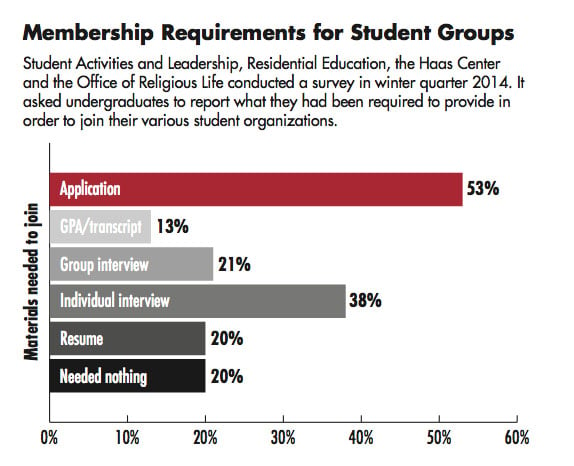
In response to the concern that some of Stanford’s Voluntary Student Organizations (VSOs) have become too selective, the offices of Student Activities and Leadership (SAL), Residential Education, the Haas Center and the Office of Religious Life brought together a working group of staff in order to assess the membership policies of student organizations.
“There were issues about selectivity and how hard it is to join some groups,” said Snehal Naik, assistant dean and associate director of SAL. “We were having some discussions and over time we have had concerns and complaints to come to us around particular organizations that students are not able to join as a member.”
In order to learn more about the problems students were experiencing, SAL administered a survey via Qualtrics to a random sample of 1,500 undergraduates and 1,200 graduate students between Feb. 27 and March 7 earlier this year, asking questions about the student organization community on campus, particularly if organizations practice offering students open and easy access to joining VSOs.
Of the random sampling, 491 undergraduates and 418 graduate students responded, a total of 909 unique responses.
Naik reported differences in the results of the survey between the undergraduate and graduate student populations, namely that 75 percent of undergraduates reported being involved in a registered student organization compared to 60 percent of graduate students.
Additionally, the two groups of students provided different reasons for difficulties in joining student organizations. While graduate students mentioned having a hard time figuring how to join organizations or even what organizations existed, undergraduates found difficulties in joining for various other reasons.
“In a qualitative analysis of student comments, we found that 44 percent of undergraduates felt that it was difficult to get involved in the first place, 36 percent because of selectivity before joining the groups — particularly in pre-professional, club sport or performing arts groups — 11 percent felt intimidated to join and nine percent didn’t have time to join,” Naik said.
SAL estimates that 20 to 30 percent of student groups require students to go through “strict application processes,” asking for interviews, resumes and transcripts, among other things. However, the office does not encourage this selectivity.
In an interview with The Daily last year, Nanci Howe, associate dean and director of SAL, said that although some group’s selective procedures are acceptable, others violate the mission of VSOs.
“The criteria for selecting members should be objective and is critical to the operation of the group,” Howe said. “For example, a cappella groups have auditions and everyone has the opportunity to audition. As long as those auditions are open to everyone and there is a fair and non-discriminatory process for choosing who can participate and be selected, then we would consider that within the guidelines of objective criteria.”
While SAL understands that certain activities and the lack of particular resources — like one-on-one mentoring opportunities — might limit the number of members that organizations can take in, SAL plans to work with student groups in order to find the happy medium and ensure that all students continue to have open and easy access to student organizations.
Because the University is an educational institution, Naik said, student organizations should provide students with learning opportunities, as opposed to preventing them from joining.
“More conversations will lead to working with more groups how we can best support the student leaders and student organizations and the students that are interested [in those groups],” Naik said. “Some of these practices may have been going on for years and we could have discussions with student organizations to see how they can be more broadly open to students that demonstrate interest.”
Contact Catherine Zaw at czaw13 ‘at’ Stanford ‘dot’ edu.